Horrockses

Horrockses was originally established by John Horrocks as a textile manufacturer in 1791. Known for their household cottons, they developed Horrockses Fashions in 1946 after the war, and they quickly became an iconic British label. They were able to create brand exclusivity within the ready-to-wear market, using only their textiles and working with in-house textile artists and well-known artists to create their unique prints.

Every season ushered in 70-80 different fabric designs, used across a collection of 150-160 dress styles! Cotton was typically not regarded as a desirable fabric in the same way as silk, but in 1940 the Cotton Board was created and the appeal of well crafted, washable, soft cotton became popular thanks to Horrockses colourful prints and designs.

They also sold their cottons as dressmaking fabrics. helping to popularize the fabric as the colours were as vibrant as fine silks.
Their company became an institution within the British fashion industry, and Queen Elizabeth I wore several Horrockses dresses on her 1953 Commonwealth tour.


Princess Margaret also had several of their dresses, and they provided the wardrobe to British films like "It Always Rains on Sunday" and "Where No Vultures Fly". Replicas of these dresses were then made so the average (although still wealthy) woman could wear the same dresses as the royals. They were still expensive, costing usually a weeks' worth of wages, but still an affordable luxury for middle class women.

Below is a 1960s dress that belonged to Princess Margaret that sold at Kerry Taylor Auctions in 2016!


This is a sweet little Horrockses' dress in the shop:
Nat Kaplan

Nat Kaplan inc. was a dress manufacturing company established by Nathan Kaplan around 1935. He was a member of the Fashion Originators Guild in the 30s. His company made moderately expensive RTW, at a few hundred dollars per dress mid-century. Their dresses were mostly conservative, meant for wealthy ladies who lunch, and impressively tailored. Originally mostly using silk, they relied heavily on synthetics by the 70s, as did most fashion companies at the time. The prices remained just as high.

After his death in 1956, his wife Sylvia and son Richard continued with the business for another 30 years, with Sylvia as designer. They created a division called Kappi. The company closed in 1986.
In 1991, Richard created another women’s line, the Worth Collection. He passed away in 1996.
We happen to have a great 50s Nat Kaplan dress for sale right now. Click the image below.
Le Chateau

Founded in Montreal in 1959 by Herschel Segal as a menswear store, selling overstock from Herschel’s father’s old store Peerless Clothing Manufacturing Ltd. Le Chateau was a name that played up the francophone feelings budding in Quebec at the time. He began importing European fashion in 1962 including the latest Carnaby street styles, French suits and Italian turtleneck sweaters. They also started selling womenswear. Segal claims that Le Château was the first to introduce bell bottoms to Canada, and had the latest European fashion before it even arrived in New York. He dropped the older clothing he had been selling and focused entirely on youth fashions.
Le Château played a little known role in John Lennon and Yoko Ono's 1969 Montreal bed-in. The bellboy at the hotel was Tony Lashta and he picked up a couple of bell-bottom black velour jumpsuits from Le Chateau for the pair. Lennon and Ono returned to Montreal in December following the bed-in, wearing the Le Chateau jumpsuits that Tony had picked up for them! Founder Herschel Segal then visited them at their hotel.
“The key thing about the outfits that was revolutionary was the concept of the unisex look,” says Franco Rocchi (senior vice-president of Le Château) in an interview with the National Post, adding that during the 1960s, clothing stores were still gender specific.

By 1972, the chain grew to 10 stores, and by the end of the decade Le Château had over 50 stores across Canada. The company shifted to selling mainstream fashion instead of the latest imports from Europe.
By the early 1990s, Le Château had 160 stores and had switched to doing most of its design and manufacturing itself. In the mid 90s, Le Château experimented briefly with Goth styled clothing.

It restructured and rebranded in the 2000s after developing a reputation for cheap, faddy clothing.
It went bankrupt in 2020 and closed all its 123 stores across Canada.
Fashion Frocks Inc.
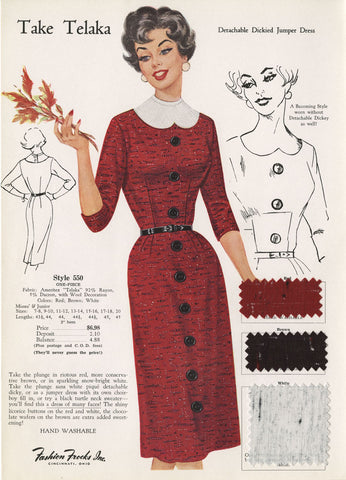
After working a few years for his father's Princess Garment Company, Philip M. Meyers founded Fashion Frocks, Inc. in 1925. Employing mostly women (and mostly homemakers), the company sold their garments door-to-door utilizing style cards. Housewives chose the outfit they wanted based on the image and description on the card. A sample of the fabric was attached to each card.

The salesperson noted colours, price, deposit, and shipping information on the back of the card. They also contained inventive marketing pitches. After selection, the style cards would be returned to the manufacturing company based in Cincinnati, Ohio for processing. In the 1950's, the dresses were sold in home parties much like the famous Tupperware parties. This model was a way of bypassing the retailers and selling directly to consumers, at better value-pricing. At the height of their success, the company reported serving one million customers in the United States. The company ceased operations in the 1970s.
Click the image below to go to our listing for this sublime black 50s Fashion Frocks dress.
Harford Frocks

Harford frocks was another very similar direct sales company to Fashion Frocks, from Cincinnati. Perhaps a rival? Couldn’t find too much info, so if anyone knows more, please let us know!
The president was Charles Israel, who arrived in Cincinnati in the early 1930s. He was a social activist working for the benefit of the Jewish community in Cincinnati. It looks like the company operated from at least between the 20s and 70s- so Charles might not have been the founder. They advertised in cheap magazines and comics and had three size ranges- junior, misses and half sizes.
In 1937, Ohio flooded and their building was damaged. Harford Frocks sued their insurance company because they refused to pay for the damage. The insurance company won the case.
They have beautiful sales/ style cards.

Doncaster/ Tanner


By the 1950s, they were exclusively producing womenswear. They used a supply of fabrics coming from local mills. A call from the Junior League in Charlotte, NC introduced the idea of selling the designs through their organization to raise funds for their civic projects. Many sellers of Doncaster had connections to their local Junior Leagues, which were helpful for tapping into a network of potential customers. They sold at parties and clothing shows. Four times a year, the collections were shown in consultants homes, where customers were guided as to what would work for them. The consultants got a 25% commission. Items were then ordered and delivered to the customers homes. They hired designers such as Dorothy Cox. The Tanner brand was also launched, which could be purchased in retail stores. By the 90s, there were over 700 people employed by Doncaster and Tanner. Their clothing has been featured on the pages of Vogue as well as in the New York Times and Chicago Tribune. After over 80 years in business, Doncaster went bankrupt in 2017.


Henry Rosenfeld
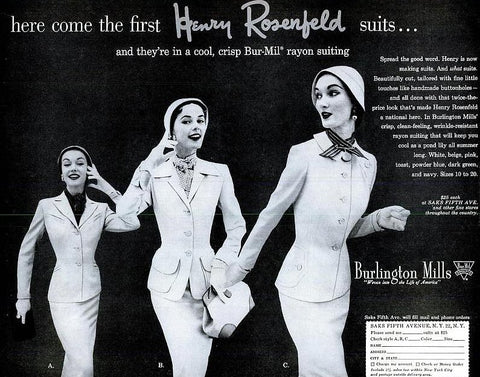
Henry was from the Bronx and worked as a shipping clerk and a salesman before setting up his own company in 1942, producing well-made suits and dresses for a budget price. His garments sold at Lord and Taylor department store among others. Within a few years, he was taking in an annual sum of $15 million. He had a strong following amongst middle-class women and during his heyday, he was called the ‘Henry Ford of the dress business’ and the ‘Christian Dior from the Bronx’! Elizabeth Hilt was a designer at the company.
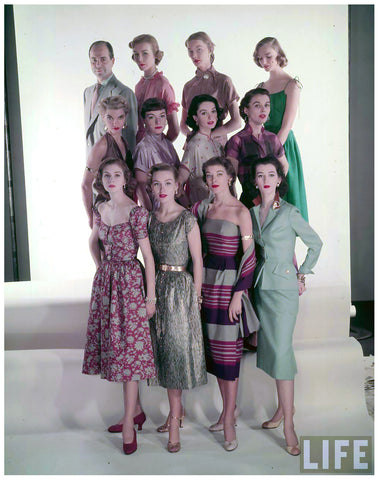
He was romantically involved with Marilyn Monroe and the two were close friends right up until her death. She had asked him to reproduce one of her favourite dresses by another designer in an array of fabric and colours.

He retired in 1964, liquidating his company because he didn’t want anyone else to run it. He didn’t stay retired for long, however and dabbled in many other business ventures before establishing Henry Rosenfeld Luggage in 1975, which licenses designer names likes Yves Saint Laurent, Oscar de la Renta and Gloria Vanderbilt.
He died at age 75 in 1986.

We have a beautiful 1950s Henry Rosenfeld skirt suit in stock.
Leslie Fay
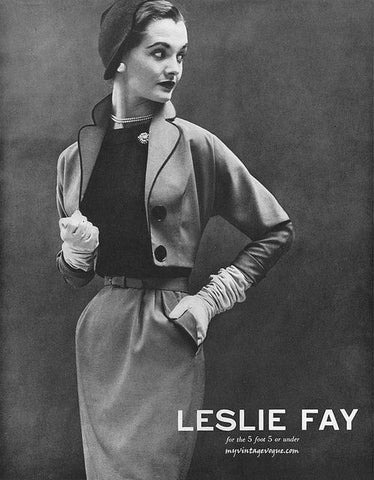
Leslie Fay was an apparel company founded in 1947 by Fred Pomerantz who named it after his daughter. Pomerantz had produced women’s army corps uniforms during WWII using sizing statistics provided by the government so that the uniforms would have the best standard fit possible. He employed the sizing methods used for the uniforms to his line of women’s dresses and sportswear. He offered department stores substantial profit margins. They mostly produced affordable, conservative but stylish dresses and suits for middle aged women. The company went public in 1952. In 1956, they launched a Leslie Pomer label aimed at younger women and teens. Other labels they launched included Joan Leslie and Andrea Gayle.

Fred’s son John became the president in 1972. In the 1980s when most large companies were turning to computers, Leslie Fay continued to do business the old fashioned way. The company was taken over in 1982 through a buyout of $58 million. It was bought out again in 1984 for $158 million. It acquired several companies in the late 80s including Albert Nipon. Leslie Fay was criticized for being too drab and matronly and it responded to this by bringing in new designers and updating its marketing, following the lead of brands like Calvin Klein and Liz Claiborne. In 1990, total sales came to $859 million. It licensed out its name to other manufacturers and reduced its prices by 10% in the early 90s. In 1993, it emerged that the company had been cooking its books to show profits that didn’t exist, which sent their shares plunging and brought lawsuits to their door. There was a workers strike at their plant, after which all their workers were fired. It entered bankruptcy protection but over the next few years, regained its footing, making large profits again by the late 90s. John Ward became the new president in 2000.
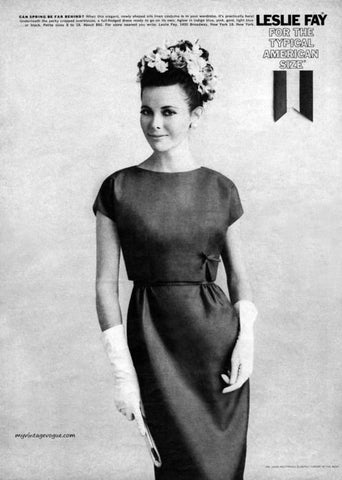
We have a beautiful satin brocade 1950s sheath dress and bolero set in the shop as well as a navy skirt suit, both by Leslie Fay ✨
These two images are from our copies of 1950s Glamour magazine:







